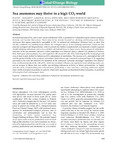Sea anemones may thrive in a high CO2 world
| dc.contributor.author | Suggett, DJ | |
| dc.contributor.author | Hall-Spencer, Jason | |
| dc.contributor.author | Rodolfo-Metalpa, R | |
| dc.contributor.author | Boatman, TG | |
| dc.contributor.author | Payton, R | |
| dc.contributor.author | Pettay, DT | |
| dc.contributor.author | Johnson, VR | |
| dc.contributor.author | Warner, ME | |
| dc.contributor.author | Lawson, T | |
| dc.date.accessioned | 2013-02-20T09:08:24Z | |
| dc.date.available | 2013-02-20T09:08:24Z | |
| dc.date.issued | 2012-10 | |
| dc.identifier.issn | 1354-1013 | |
| dc.identifier.issn | 1365-2486 | |
| dc.identifier.uri | http://hdl.handle.net/10026.1/1332 | |
| dc.description.abstract |
<jats:title>Abstract</jats:title><jats:p>Increased seawater <jats:italic>p</jats:italic>CO<jats:sub>2</jats:sub>, and in turn ‘ocean acidification’ (OA), is predicted to profoundly impact marine ecosystem diversity and function this century. Much research has already focussed on calcifying reef‐forming corals (Class: Anthozoa) that appear particularly susceptible to OA via reduced net calcification. However, here we show that OA‐like conditions can simultaneously enhance the ecological success of non‐calcifying anthozoans, which not only play key ecological and biogeochemical roles in present day benthic ecosystems but also represent a model organism should calcifying anthozoans exist as less calcified (soft‐bodied) forms in future oceans. Increased growth (abundance and size) of the sea anemone (<jats:italic>Anemonia viridis</jats:italic>) population was observed along a natural CO<jats:sub>2</jats:sub> gradient at Vulcano, Italy. Both gross photosynthesis (<jats:italic>P</jats:italic><jats:sub>G</jats:sub>) and respiration (R) increased with <jats:italic>p</jats:italic>CO<jats:sub>2</jats:sub> indicating that the increased growth was, at least in part, fuelled by bottom up (CO<jats:sub>2</jats:sub> stimulation) of metabolism. The increase of <jats:italic>P</jats:italic><jats:sub>G</jats:sub> outweighed that of R and the genetic identity of the symbiotic microalgae (<jats:italic>Symbiodinium</jats:italic> spp.) remained unchanged (type A19) suggesting proximity to the vent site relieved CO<jats:sub>2</jats:sub> limitation of the anemones' symbiotic microalgal population. Our observations of enhanced productivity with <jats:italic>p</jats:italic>CO<jats:sub>2</jats:sub>, which are consistent with previous reports for some calcifying corals, convey an increase in fitness that may enable non‐calcifying anthozoans to thrive in future environments, i.e. higher seawater <jats:italic>p</jats:italic>CO<jats:sub>2</jats:sub>. Understanding how CO<jats:sub>2</jats:sub>‐enhanced productivity of non‐ (and less‐) calcifying anthozoans applies more widely to tropical ecosystems is a priority where such organisms can dominate benthic ecosystems, in particular following localized anthropogenic stress.</jats:p> | |
| dc.format.extent | 3015-3025 | |
| dc.format.medium | Print-Electronic | |
| dc.language | en | |
| dc.language.iso | en | |
| dc.publisher | Wiley | |
| dc.subject | Cnidarian | |
| dc.subject | CO2 vent | |
| dc.subject | Ocean acidification | |
| dc.subject | Productivity | |
| dc.subject | Sea anemone | |
| dc.subject | Symbiodinium spp | |
| dc.title | Sea anemones may thrive in a high CO2 world | |
| dc.type | journal-article | |
| dc.type | Article | |
| plymouth.author-url | http://gateway.webofknowledge.com/gateway/Gateway.cgi?GWVersion=2&SrcApp=PARTNER_APP&SrcAuth=LinksAMR&KeyUT=000308443800004&DestLinkType=FullRecord&DestApp=ALL_WOS&UsrCustomerID=11bb513d99f797142bcfeffcc58ea008 | |
| plymouth.issue | 10 | |
| plymouth.volume | 18 | |
| plymouth.publication-status | Published | |
| plymouth.journal | GLOBAL CHANGE BIOLOGY | |
| dc.identifier.doi | 10.1111/j.1365-2486.2012.02767.x | |
| plymouth.organisational-group | /Plymouth | |
| plymouth.organisational-group | /Plymouth/Faculty of Science and Engineering | |
| plymouth.organisational-group | /Plymouth/Faculty of Science and Engineering/School of Biological and Marine Sciences | |
| plymouth.organisational-group | /Plymouth/PRIMaRE Publications | |
| plymouth.organisational-group | /Plymouth/REF 2021 Researchers by UoA | |
| plymouth.organisational-group | /Plymouth/REF 2021 Researchers by UoA/UoA07 Earth Systems and Environmental Sciences | |
| plymouth.organisational-group | /Plymouth/Research Groups | |
| plymouth.organisational-group | /Plymouth/Research Groups/Marine Institute | |
| plymouth.organisational-group | /Plymouth/Users by role | |
| plymouth.organisational-group | /Plymouth/Users by role/Academics | |
| dc.publisher.place | England | |
| dcterms.dateAccepted | 2012-06-05 | |
| dc.identifier.eissn | 1365-2486 | |
| dc.rights.embargoperiod | Not known | |
| rioxxterms.versionofrecord | 10.1111/j.1365-2486.2012.02767.x | |
| rioxxterms.licenseref.uri | http://www.rioxx.net/licenses/all-rights-reserved | |
| rioxxterms.type | Journal Article/Review |


